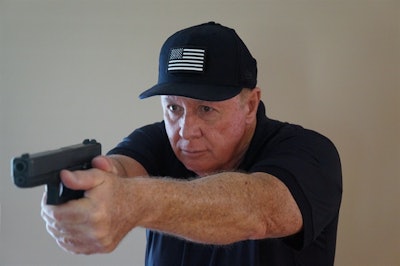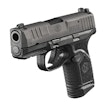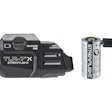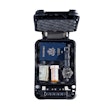But after serving many years in law enforcement, I have made some observations and conclusions regarding handguns, and to a lesser degree rifles. The most important of these observations is that with apologies to Cooper and Weaver, I'm not sure of the absolute importance of how one stands with a handgun in any given incident.
After many years of viewing videos involving both officers and civilians and reading after-action reports, I have concluded that the person fighting with a handgun will most often resort to whatever stance they can achieve and concentrate more on pointing and shooting the handgun at the threat facing them.
If you don't believe me I suggest you go to "YouTube" and search for "dash cam officer-involved shootings." What you will see in the videos of officers in deadly force encounters with handguns is that when the officer or the suspect perceives a threat they start to move to get out of the "kill zone." This holds true with anyone in a deadly force incident. Having had that experience a number of times, I can validate this conclusion.
So that leaves us with what I euphemistically refer to as the trifecta of handgun techniques: grip, trigger control, and aiming. There are others but these are the core skills. In the final analysis it is these three essential fundamentals that must be anchored firmly into your skill set.
Nowadays I find myself teaching students who may have grown up with guns but have never been taught any formal technique as opposed to police officers, military members, or police cadets. When shown how to grip the handgun and control the trigger, and aim it correctly they seem to be amazed. I coach the students in the proper techniques and just as importantly, I give them the why behind these techniques.
Up to now when asked "Why do we do this?" the standard response has been because this or that is the best way to control the handgun and to minimize the movement brought to the process by every person who shoots a handgun. This is a learned response from years of watching and listening and learning from other instructors. While this is true I constantly look for other options to give to shooters. So let's begin with grip.
Holding a Handgun
If your grip is wrong, trigger control and aiming will be harder if not impossible to do correctly.
There are several points of contact on the grip of your pistol that you must grasp correctly. The first point of contact starts with the web of your hand being placed high on the back-strap of your pistol. Gripping the pistol low on the back-strap will result in many people not being able to correctly place their index finger in the proper place on the face of the trigger.
This causes two additional things to happen. First, you will adjust your grip to reach for the trigger, which tends to throw your aiming off. Second, having your hand too low on the back-strap will force you to fight your pistol's tendency to buck backwards or rotate backwards when it recoils, which breaks down the shooter's wrist. This will cause you to not be able to follow through and make quick follow-up shots.
Dave Spaulding offers newer, well thought out alternatives to gripping the pistol. He advocates that you make sure when drawing and gripping a pistol that you hit the spot where the grip and the trigger guard meet with the top of your middle finger on your shooting hand, so that when you wrap the rest of your hand around the grip you naturally are high on the back-strap. Remember, this is all just the shooting hand.
Next, when you add the support hand you need to first cam or cant your wrist forward, pointing your thumb in the direction of your barrel. Now, wrap all of your fingers around the front of your shooting hand, making sure you touch the top of your support hand index finger under the trigger guard.
I know from watching many shooters that a lot of them want to extend the support hand index finger out and around the front of the trigger guard. This position, however, opens your grip and allows less control of the recoil. Additionally it plays into both of your hands' sympathetic reflex.
Some instructors recommend a split in the grip strength such as 60% with support hand or even a crush grip and 40% with your shooting hand. I believe this is extremely difficult to achieve for the average shooter. You must have a very firm grip. When you fire a shot, if the pistol moves in your hands and you have to readjust your grip you are not gripping firmly enough. Grip a little tighter and try another shot. You will eventually know what your grip strength should be. It will be different for every shooter.
Minimizing Trigger Movement
Trigger control is our next point to consider. Remember controlling the trigger controls your pistol. Good finger placement is critical here as the geometry of pressing a trigger is not a natural movement. About halfway between the tip of your index finger and the first knuckle is the place to be.
We have all seen and felt the movement in most of our pistol triggers and it varies between makes of pistols. The movement comes from the fact that most common pistols have a pivot pin above the trigger in the frame that allows the trigger to sweep back and forth like a pendulum. This makes it all but impossible to keep your finger in the same spot on the face of the trigger. But your trigger finger needs to remain in contact with the face of trigger through any sequence of shots fired.
The only trigger in a common make of pistol that does not pivot is the one on the 1911 platform pistols. It has a draw bar that moves the trigger straight back and forth and more naturally minimizes the movement that the human hand brings to the pistol. Competition shooters favor this type of pistol in many configurations because it has this trigger.
The last element of trigger control involves minimizing the movement of the trigger, thereby not moving your sights more than necessary to fire the shot.
Let's define some terms before we continue this discussion.
Trigger "pre-travel" is when a shooter places their finger on the face of the trigger and begins to depress the trigger. There will be a certain amount of movement until the trigger reaches the "break." The break is that point in the depression of the trigger where the trigger discharges the pistol. "Over-travel" is movement of the trigger after the trigger is depressed past the break. "Reset" is when the trigger makes a complete stop at the end of over-travel and the shooter then rides the trigger forward to a point where a felt and an audible click is detected. At this point the trigger is reset and can be depressed again for another shot. The shooter need not allow the trigger to ride any farther forward than reset. Any additional movement of the trigger more often than not results in movement of the pistol during a shot fired and disturbs and moves the gun's sights, making the shots inaccurate.
Alignment and Picture
The last piece of the puzzle is aiming the pistol. Aiming a pistol comes with two components: sight alignment, and sight picture. The first component, sight alignment, is merely correctly aligning the rear sight and the front sight, while the sight picture is created by placing the aligned sights on your target.
Aligning the sight requires you to look through the back notch on the rear sight, then locate the front sight and center it in that notch. You must align the top of the rear and front sights and allow equal distance on either side of the front sight again, as you are looking through the back notch. To achieve the second component, sight picture, you must place the aligned sights on the target where you want your bullets to hit.
So remember grip, trigger control, and aiming. If your grip is incorrect you will not be able to correctly control your trigger. An incorrect grip will produce a pistol that is out of alignment with your body, thus you will be unable to properly align your sights and create a sight picture that will result in accurate shots. The fundamentals must flow from one to the other or you will likely not reach your potential or your goals of being an accurate shooter. With practice you can master all three of these essential skills and become an excellent shooter who can shoot both quickly and accurately.
Gordon Beck served 36 years in law enforcement, retiring as a chief. In his career Beck held assignments in patrol, investigation, SWAT, and training. Currently he is the training director at a private sector indoor range and retail facility, instructing civilian students in the fundamentals of firearms.
















